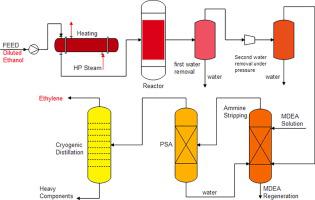Journal of Industrial and Engineering Chemistry ( IF 5.9 ) Pub Date : 2021-08-28 , DOI: 10.1016/j.jiec.2021.08.026 Martina Frosi 1 , Antonio Tripodi 1 , Francesco Conte 1 , Gianguido Ramis 2 , Nader Mahinpey 3 , Ilenia Rossetti 1

|
At present, ethylene is the most widely produced organic compound in the chemical industry. The main commercial way to obtain ethylene is by steam cracking of a wide range of hydrocarbon feedstocks, but biomass-derived ethanol can be catalytically dehydrated as a sustainable alternative route in order to exploit new renewable sources. The aim of this work is to design an optimal bioethanol-to-bioethylene plant, with a capacity of 445,652 ton/year, and to assess its economic feasibility. This design features an improved production capacity and intensified energy management.
The main novelty of this study is the use of diluted bioethanol solutions, bypassing the energy intensive and expensive dehydration step. Moreover, while the first industrial bioethanol-to-bioethylene process uses NaOH to purify the outcoming flow from CO2, this plant uses diluted Methyldiethanolamine (MDEA), regenerated in situ. With this plant, the double of the capacity of the Braskem’s plant, now the largest one, can be reached in an environmentally more sustainable manner.
A pinch analysis was performed, in order to minimize the energy consumption of the process by optimizing the heat recovery systems. The economic analysis of the process consists of the evaluation of the total cost of the plant (TOC) including the sum of the CAPital EXpenditures (CAPEX) and the OPerating ones (OPEX), together with some sensitive profitability indexes (net yearly profit, net present value, net rate of return and cash flow analysis). The designed process presents an economically competitive solution compared to the current bioethylene production units.
Assuming a premium price of between 0.293 $/kg for diluted bioethanol, the proposed plant is competitive with the lowest production cost for bioethylene (Brazil and India), while a sensitivity analysis on diluted bioethanol price evidenced that this option remains competitive still in Europe with a bioethanol cost 0.65 $/kg.
中文翻译:

可再生乙醇制乙烯:工艺优化和经济可行性评估
目前,乙烯是化学工业中生产最广泛的有机化合物。获得乙烯的主要商业方式是通过蒸汽裂解各种烃类原料,但生物质衍生的乙醇可以催化脱水作为可持续的替代途径,以开发新的可再生资源。这项工作的目的是设计一个产能为 445,652 吨/年的最佳生物乙醇制生物乙烯工厂,并评估其经济可行性。这种设计的特点是提高了生产能力和强化了能源管理。
这项研究的主要新颖之处在于使用稀释的生物乙醇溶液,绕过了能源密集型和昂贵的脱水步骤。此外,虽然第一个工业生物乙醇到生物乙烯过程使用 NaOH 净化来自 CO 2 的流出物,但该工厂使用稀释的甲基二乙醇胺 (MDEA),原位再生。有了这个工厂,Braskem 工厂(现在是最大的工厂)的产能可以以更环保的方式实现两倍。
进行了夹点分析,以通过优化热回收系统来最小化过程的能源消耗。该过程的经济分析包括对工厂总成本 (TOC) 的评估,包括资本支出 (CAPEX) 和运营支出 (OPEX) 的总和,以及一些敏感的盈利指标(净年利润、净现值、净收益率和现金流量分析)。与当前的生物乙烯生产装置相比,设计的工艺提供了一种经济上具有竞争力的解决方案。
假设稀释生物乙醇的溢价在 0.293 美元/公斤之间,拟议的工厂在生物乙烯生产成本最低的情况下具有竞争力(巴西和印度),而对稀释生物乙醇价格的敏感性分析表明,这种选择在欧洲仍然具有竞争力生物乙醇的成本为 0.65 美元/公斤。











































 京公网安备 11010802027423号
京公网安备 11010802027423号